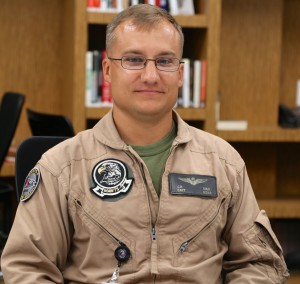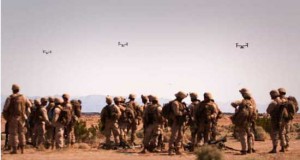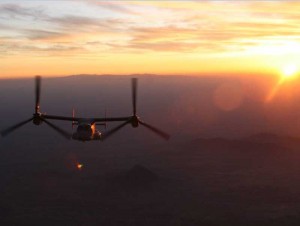2014-07-30 By Robbin Laird and Ed Timperlake
During our time at MAWTS-1, we had a chance to talk with Captain Justin “Lumbergh” Sing who represents the new generation of Osprey operators who have not transitioned from other platforms.
I have not flown any other fleet aircraft.
I went through the flight school syllabus and straight to the MV-22 FRS.

Captain Sing had just joined MAWTS and had been there only three days.
He had two tours at sea with the 26th MEU as part of VMM-266(REIN).
The 26th MEU was involved in the Odyssey Dawn Operation, but Captain Sing was part of the split Osprey force and was serving in Afghanistan during that operation. Sing served under Col. Romin Dasmalchi for his first tour and Lt. Col. Christopher Boniface for the second.
Readers of Second Line of Defense are certainly not stranger with regard to Lt. Col. Boniface.
During his time in Afghanistan, the Marines were expanding the operational envelope for the Osprey.
We started utilizing V22 aircraft for the named operations in a new area previously unoccupied by US forces while I was there.
Question: Day and night missions?
Both.
The first named mission I ever flew was a night insert.
The V22 community initially had issues with the dust cloud associated with brownout landings imposing an additional component to the “fog of war” encountered by the grunts during inserts.
It got worked out through TTP development and a good working relationship with the infantry.
He described one mission in Afghanistan in which the Osprey landed Marines and then quickly came back to move them out of harm’s way.
The quick turn-around capability of the Osprey is an important capability for the “devil dogs” coming out of the back of an Osprey.
Two Ospreys inserted troops to a particular landing zone, one on either side of a tree line.
We departed and repositioned to a laager point about 15NM away.
Fairly soon after, we were called back to move the Marines out of a suspected IED infested area.
They could not safely cross the tree-lined ditch at night.
The next day we found out that the Landing Zone (LZ) where we had conducted the insert had IEDs in it.
We just happened to not land on any.
That was our first operation after our unit had just arrived in Afghanistan.

Captain Sing highlighted the quick turnaround time, which the Osprey was able to provide to the troops on the ground.
From the time they called for immediate re-embark when we were on deck at the laager point, to the time they were repositioned, which included us landing, them loading, and us hopping the tree line and landing again was probably less than 15 minutes.
Captain Sing highlighted the impact of speed in an emergency medical situation as well.
We were onboard the ship, and had a sailor with a gallbladder issue. It was about to rupture and they needed to get him to a medical facility.
We were just north of Somalia in the Horn of Africa, and the closest medical care facility was in Mombasa down in Kenya.
This happened while a party was being held on the flight deck, with no flight ops schedule that day. We needed to get this guy to medical care.
The deck crew cleared the front half of the boat, and pulled the V22 out on spot within 45 minutes, and we were in the air 45 minutes later.
We had to tank on the way, but we had him on deck in Mombasa, Kenya roughly 1,100NM away within 4+30 hours after takeoff.
When asked how the Osprey had advantages over rotorcraft in approaching LZs, the Captain highlighted the advantage of a lower audible signature.
We can maintain an audible standoff for a little bit longer by staying in airplane mode up at altitude and only descending when approaching the objective area.
It really reduces the enemy’s ability to know we’re coming,
The aspect of range was highlighted by a self-deployment discussed by Captain Sing.
When we were complete with required operations, we self-deployed from Afghanistan back to Greece.
It was the longest flight a V22 had done at the time.
It was longer than the flight across the Atlantic to go to Farnborough, which had been the longest flight before.

The deployment was necessary as part of the force build up for Odyssey Dawn.
We had four planes conducting alert for Odyssey Dawn when the TRAP mission in Libya was executed.
In order to reconstitute the unit we flew three V22s and two C-130s in one day, a 16-hour flight total time, from Afghanistan to Souda Bay.
The C-130s turned around the next day, flew back to Afghanistan, and then the following day conducted the flight again with the remaining three V22s.
All six V22s, flew a one-shot from Afghanistan to Souda Bay over a three day period.
The only real limiting factor in the time period for execution was the external tanker availability.
Captain Sing highlighted that the Osprey was both a very easy plane to fly but an unforgiving one as well if it was not properly respected.
It’s an easy plane to fly, it really is.
In VTOL you’re dealing with a rotor head with a vectored thrust component, and there’s a lot of aerodynamics at play.
The vectored thrust is what makes it unique and allows for an increased range of capabilities; but where we really see the gains are in the ability to fly like an airplane during the enroute portion of any mission.
It’s a great aircraft with a lot of capability.
The Captain was asked about his focus at MAWTS-1 on the next steps for the Osprey.
I think digital interoperability is the next step for us.
Also, the over-the-horizon capability, figuring out how we’re going to provide ourselves some eyes on the objective area before we get there, as we’re going to be the ones with the range capability to conduct those over the horizon inserts.
The Captain provided a sense of how he saw the path towards this end state.
We’re working on flying with a bigger communications package that allows us to have digital interoperability in communications with most wave forms.
This would increase our capacity to inform the ground force commander in real time on the way to the objective area and increase his situational awareness to help ensure preconditions for insert have been met prior to placing boots on the deck.
The ability to pull information from multiple sources in real time would be a significant enhancement to capability.

